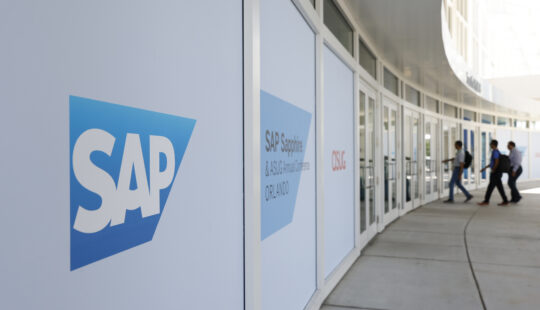Businesses are defined not just by the objectives achieved and innovations delivered ahead of the competition, but how well they harness data to make them happen. But first, this intelligence must be organized and managed with a strong digital backbone. What’s needed is one data platform.
Most organizations have spent the last several years deploying new technologies in a legacy infrastructure to deliver high-demand capabilities such as personalized experiences, process automation, and predictive maintenance.
While these digital investments fulfill well-defined business needs, they rarely lead to a data architecture that is simplified enough to accelerate future innovation and help ensure the integrity of every artificial intelligence (AI) model. Unfortunately, current market dynamics are not compatible with companies that cannot pivot, adapt, and respond to change quickly.
Businesses must align their processes with customer experiences and analyze those connections for deep insights that lead to confident, trusted decisions and actions. Only then can organizations drive continuous innovation.
Achieving such an interconnected landscape of systems, processes, and data requires an agile digital backbone infused with intelligence to redefine and create new business models and processes in a more dynamic fashion. And a majority of executives seem to be getting the message: 65 percent of organizations surveyed by IDC indicated plans for aggressive modernization of legacy systems with extensive new technology platform investments through 2023.
Setting the Foundation for Real-Time Data Organization and Access
Searching for a platform that can quickly organize data and enable access is easier said than done. It’s true that a wide variety of platform technologies promise to consolidate and harmonize data into one architecture. However, those that are comprehensive and scalable enough to support requirements that range from basic analytics to sophisticated data intelligence and algorithms provide the foundation businesses need to become genuinely data centric. This approach is what we call “one data platform.”
The one data platform approach integrates heterogeneous solution components into a cohesive fit-for-purpose data management environment. This design delivers business-centric platform services that converge with common systems and leverage cloud concepts – all while lowering IT costs.
The platform’s architecture groups technologies into four decipherable layers: data analytics, data integration, data ingestion pipelines, and source systems. This tactic is not meant to provide a one-size-fits-all structure. Instead, it should encourage IT architects to consider the distinct functions of each layer to create an environment that scales with the business as market dynamics and customer expectations evolve.
Layer #1: Data Analytics
Users can choose to leverage standardized dashboards with guided navigation and storytelling or customize their view for ad hoc analysis.
The data science behind this layer turns information mining into new information models that can be extended with enterprise-scale data. Furthermore, organizations can blend and manage Big Data from multiple sources and apply statistical methods, algorithms, and analytic engines to tease out relevant, in-the-moment insights that help improve the bottom line.
Layer #2: Data Integration
As a data integration hub, this layer moves the needle on data-driven business transformation by getting data assets out from siloed sources, exposing them for different applications and systems to consume, and accelerating opportunities for self-service analytics.
Within this layer, a multi-node production system enables mission-critical data warehousing functions for several business domains and across divisions. A near-line storage solution is also available for archiving and accessing massive data volumes cost effectively.
Meanwhile, containerized data systems increase the computing power by providing self-contained modular technical areas that cater to specific business domains and requirements, such as country-specific reporting. Ingested data sets are then confined within a container, allowing analytical data models to be flexibly and independently deployed.
Layer #3: Data Ingestion Pipelines
This layer provides transformation, filtering, and integrated data type mapping capabilities. It enables agile data delivery and feeds insights into business processes through continuous data provisioning across a wide range of sources. More importantly, streaming data can be handled to support use cases that require real-time data management – from capture and processing to analysis, reporting, and decision-making.
Layer #4: Source Systems
This area houses the entire ecosystem of existing technology. Internal and external packaged applications, homegrown solutions, systems of record, and enterprise data repositories are brought together to create a centralized intelligence core that accurately reflects every stakeholder’s needs.
Smoothing the Road to a Hybrid, Multi-Cloud Landscape
In addition to reassessing the harmonization of their IT architecture, organizations are upgrading their global data center strategy as the pace of change continues to accelerate. With the assistance of SAP Advisory Services, many SAP customers have even taken steps toward fully transitioning their data platform to public and private cloud infrastructures to rapidly deploy the latest data-driven innovations at scale.
For example, some of our customers consider cloud-based infrastructure as a service (IaaS). An IaaS strategy enables organizations to replace on-premise infrastructure with elastic pay-per-use infrastructure that can scale up or down rapidly on demand. Efforts related to this transformation help businesses adapt to broader analytical requirements and manage rising data volumes while avoiding significant capital expenditure investments and lowering operating costs.
The target infrastructure design includes integration enablement and connectivity within and across clouds to support cross-application analytical requirements. In broad terms, migration planning considers factors such as:
- Migration approaches for various SAP and third-party solutions
- Scalability, stability, performance, reliability, and cost reduction
- Compliance and security
- Testing and validation strategies
- Monitoring and operations
- Application lifecycle management
- Alignment of the IT organizational structure to the new IaaS engagement model
Another option that other SAP customers pick is a software-as-a-service (SaaS) strategy focused on pushing their transformation into a data-driven enterprise even further. In this case, executives are interested in expanding their data warehousing capabilities to realize more business benefits from the cloud with relative ease and without creating large-scale disruptions often associated with uprooting the mission-critical enterprise data backbone.
Co-deployment of a cloud-based data warehousing solution and existing digital assets such as a business warehousing solution may appear plausible because the solutions address very different, yet mission-critical, problems. The cloud-based data warehouse solution consumes data from the business warehouse solution and other source systems with an abstraction or semantic layer, reducing IT complexity and applying much-needed governance and security.
When coupled with cloud data management and virtualization technology, the cloud-based data warehousing solution is well-positioned to provide opportunities for self-service analytics. From this perspective, it is sensible to hedge that the solution can evolve to provision user-facing and domain-based analytical services at an enterprise scale, even with a well-established business warehousing system.
Amplifying Business Value with Flexibility and Scalability
The urgency around innovating data-driven business models, processes, and products and services is not going away anytime soon. So why not strategically respond to that demand with a flexible, scalable, and structured data platform that can distill value from massive volumes of data?
For many SAP customers, taking this step is the key to hedging against uncertainty and driving business outcomes that better secure their foothold, profitability, and longer-term viability.
Explore how SAP Advisory Services can help your company reveal its true potential as a data-centric business with the one data platform approach.
Christine Lucea is a business enterprise principal consultant in Customer Success at SAP.
This article first appeared on the SAP Global News Center



